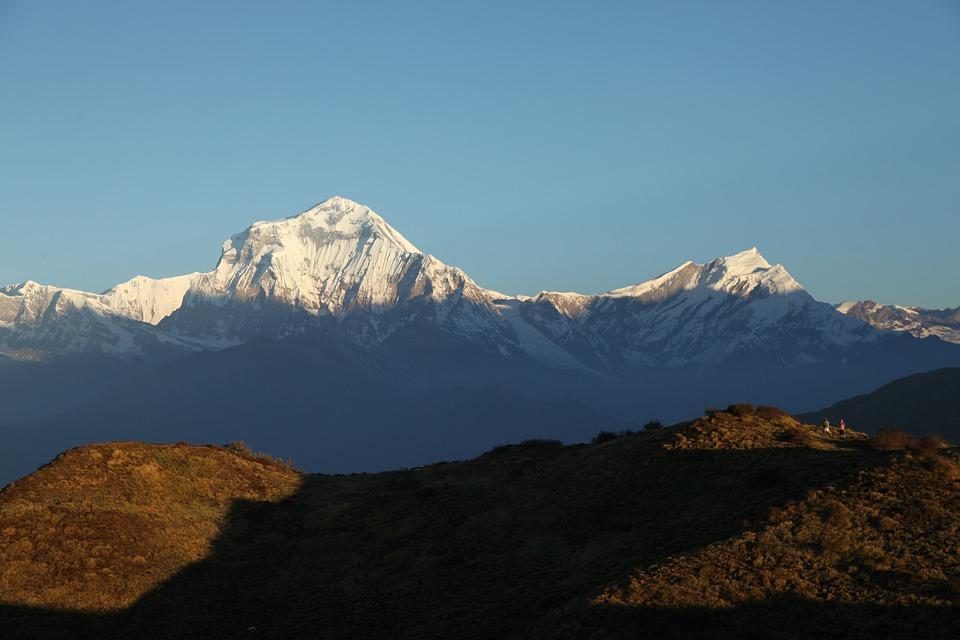One of the 8,000-meter Mountains in the world, Mt. Dhaulagiri is in the west of Annapurna region. Dhaulagiri Expedition is a climbing adventure that takes you on a trip towards the summit of the mountain.
Overview:
Mt. Dhaulagiri, which is 8,167 meters high above sea level, is the 7th highest mountain in the world. In addition, Dhaulagiri Expedition is also the highest one that entirely lies in Nepal. The Dhaulagiri climbing expedition is a climbing adventure that takes you on a trip towards the summit of the mountain. One of the 8,000-meter Mountains in the world, Mt. Dhaulagiri is in the west of Annapurna region. The Dhaulagiri Expedition stands impressively amongst many other towering peaks in the Himalayan range.
Dhaulagiri Summit Climbing Expedition: Climbing the 7th Highest Mountain on Earth
The first successful ascent of Mount Dhaulagiri was in 1960 by a joint team of climbers from Switzerland and Austria. Dhaulagiri Expedition is not only a beautiful mountain to behold but also a highly technical and challenging mountain to climb. A tricky topography of the mountain makes Dhaulagiri Peak 8167M Expedition a challengingly tough adventure.
Although it is in the close proximity to the Annapurna, the mountain is one of the lesser visited 8,000-meter mountains. The mountain’s accessibility is tougher than other expedition mountains. Thus, only a few climbers head to the mountain to climb it.
The entire trip is divided into three different categories – driving, trekking and climbing. You will actually start the climb above the base camp. You will need to drive and trek to reach the Dhaulagiri base camp. When you start the climb, you will have to spend days in different camps set up in the mountain.
Reasons this trip becomes an Experience:
Nepal Climbing Adventure always strives to offer an adventure traveling experience that you can cherish. While the Dhaulagiri Peak 8167M Expedition is beautiful in its all essence, your experience of climbing the mountain with us becomes even more beautiful.
By the time we take you to the base camp and bring you back, we take one step ahead to offer you a beautiful experience. We keep your safety and happiness as our top priority and you will experience the same during the trip.
The Dhaulagiri Mountain Expedition with us is traveling in safe hands.
Dhaulagiri Expedition History:
The Dhaulagiri Mountain expedition history is very rich. Dhaulagiri, the seventh highest mountain in the world, stands at 8,167 meters (26,795 feet). It is located in the Himalayas of north-central Nepal. The first successful ascent of Dhaulagiri was on May 13, 1960. A Swiss-Austrian team, led by Max Eiselin, made this historic climb. They used a new route, the northeast ridge, which is still popular today. This team included Kurt Diemberger, Peter Diener, Ernst Forrer, Albin Schelbert, and two Sherpas, Nawang Dorje and Nyima Dorje.
Before the successful climb in 1960, many expeditions had tried and failed. The first attempt was in 1950 by a French team. They did not reach the summit but made significant progress in understanding the mountain's challenges. The mountain's steep slopes and unpredictable weather make climbing Dhaulagiri difficult. Despite this, it has attracted many climbers over the years. Some expeditions have faced tragic outcomes, including loss of lives.
Best time for Dhaulagiri Mountain Expedition:
The best Dhaulagiri expedition season is in the pre-monsoon (spring) and post-monsoon (autumn). These periods offer the most stable weather conditions, which are crucial for a successful and safe climb.
Spring (April to early June): Spring is one of the best times for the Dhaulagiri Peak 8167M Expedition. During this season, the weather is generally more stable, with clear skies and moderate temperatures. The spring months offer good visibility and the snow conditions are usually favorable. This season is also when the mountain's flora blooms, adding beautiful scenery to the trek.
Autumn (late September to early November): Autumn is another ideal season for the expedition. The post-monsoon period brings clear skies and excellent visibility, which are essential for high-altitude climbing. The temperatures are cooler than in spring, but they are still manageable for climbers. Autumn also sees fewer chances of snowfall and avalanches, making it a safer option for mountaineers.
Avoiding Monsoon and Winter: The monsoon season (June to early September) brings heavy rainfall, which can lead to dangerous conditions such as landslides and avalanches. The winter months (late November to February) are extremely cold, with heavy snowfall and harsh weather, making the climb very challenging and risky.
Dhaulagiri Climbing Permits:
Dhaulagiri, the seventh highest mountain in the world, is a popular destination for climbers. To climb Dhaulagiri, you need specific permits. The main permit required is the Dhaulagiri Peak Climbing Expedition Permit, issued by the Nepal government. The cost of this permit varies based on the season. It is most expensive during the spring season, which is the peak climbing period. You can obtain the permit through a registered trekking agency in Nepal. You need an Annapurna Conservation Area Permit (ACAP) because the route passes through this protected area. This permit helps fund conservation efforts in the region.
Another necessary permit is the TIMS (Trekkers' Information Management System) card, which ensures your safety by tracking your trek. The application process requires detailed information about the expedition, including the team members, their experience, and the planned itinerary. You also need to provide a copy of your passport and recent photographs. It is important to follow all guidelines and regulations to ensure a safe and legal climb. Climbing Dhaulagiri is a serious endeavor and proper planning, along with obtaining the right permits, is crucial for a successful and safe expedition.
Dhaulagiri Mountain Expedition Preparation and Training:
Dhaulagiri Base Camp expedition preparation is crucial for a safe and successful climb. Dhaulagiri is the seventh-highest mountain in the world, so it requires excellent physical fitness and mountaineering skills. Start training at least six months before the expedition. Focus on cardio exercises like running, cycling, and swimming to build endurance. Strength training is essential to enhance muscle power, especially in the legs and core.
Practice hiking with a backpack to simulate the load you'll carry. Spend weekends trekking in mountainous areas to get used to the terrain. Learn and practice climbing techniques, including using crampons, ice axes, and ropes. Taking a mountaineering course can be very helpful. Acclimatization is key for high-altitude climbing. Plan to arrive early to spend time at higher altitudes before the climb. This helps your body adjust to lower oxygen levels. Hydration is crucial, so drink plenty of water.
Pack the right gear like warm clothing, a good quality sleeping bag, a sturdy tent, and proper climbing equipment. Hire experienced Dhaulagiri expedition guide and join a reputable expedition group. Mental preparation is also important. Stay positive and focused, as the climb will be physically and mentally demanding. With proper preparation and training, you can increase your chances of a successful Dhaulagiri Peak Climbing Expedition.
Trekking Difficulty During Dhaulagiri Peak Expedition :
The dhaulagiri expedition difficulty is known for its challenging terrain. Dhaulagiri, the seventh highest mountain in the world, stands at 8,167 meters. Climbing this peak is a serious challenge even for experienced mountaineers. The trek to the base camp itself is tough due to steep and rugged trails. The terrain is rocky and often covered in snow and ice, making it slippery and dangerous.
One of the main Dhaulagiri climb difficulty is the extreme altitude. Climbers face a significant risk of altitude sickness, which can be life-threatening if not properly managed. The main dhaulagiri Peak Climbing expedition difficulty is unpredictable and can change rapidly. Climbers must be prepared for strong winds, heavy snowfall, and freezing temperatures. Technical climbing skills are essential for this expedition. The Dhaulagiri ascent involves navigating crevasses, icefalls, and steep snow slopes. Fixed ropes are used in many sections, and climbers need to be proficient in using them.
Additionally, the Dhaulagiri region is remote, with limited access to rescue services. This isolation means that in case of an emergency, help may take a long time to arrive. Climbers must be self-sufficient and well-prepared for any situation. This expedition is a demanding and risky endeavor, suitable only for those with significant mountaineering experience and excellent physical fitness.
Altitude Sickness during Dhaulagiri Expedition:
Altitude sickness is a common challenge during the Dhaulagiri Base Camp Expedition. As climbers ascend, the air becomes thinner, making it harder to breathe. This can cause altitude sickness, which includes symptoms like headaches, nausea, dizziness, and fatigue. The risk of altitude sickness increases above 2,500 meters, and Dhaulagiri is 8,167 meters high. To prevent this, climbers must acclimatize properly. This means climbing slowly, taking rest days, and allowing the body to adjust to the altitude. Hydration is also crucial, as drinking plenty of water can help prevent symptoms.
Some climbers use medications like acetazolamide (Diamox) to reduce the risk of altitude sickness. Recognizing symptoms early is vital. If symptoms worsen, descending to a lower altitude is the best solution. Ignoring severe symptoms can lead to more serious conditions like high-altitude pulmonary edema (HAPE) or high-altitude cerebral edema (HACE), which are life-threatening. Experienced guides and proper planning are essential for a safe climb. They help ensure climbers acclimatize well and recognize early signs of altitude sickness. With careful preparation and awareness, climbers can improve their chances of a successful and safe Dhaulagiri Base Camp Expedition.
Dhaulagiri High Camp Expedition Cost:
The dhaulagiri expedition cost can vary widely based on several factors. Generally, it ranges from $10,000 to $15,000 per person. This price includes several key components. Firstly, there are permit fees. These can be around $1,800 per climber. Next, you have to consider the cost of hiring guides and porters, which might be about $3,000 to $5,000. Equipment and gear are essential and can cost another $1,500 to $3,000.Transportation is another major expense. Flights to Nepal, internal flights, and transport to the base camp can total around $1,500 to $2,000.
Food and accommodation during the trek and climb can add another $1,500 to $2,000. Insurance is crucial for an expedition of this nature, covering emergency evacuation and medical issues. This can be approximately $500 to $1,000. Lastly, there's the cost of training and preparation, which can also be significant, ranging from $500 to $1,000. While this expedition is a costly endeavor, the comprehensive nature of the expenses ensures safety, support, and a better chance of a successful summit. Proper planning and budgeting are key to managing these costs effectively.
Dhaulagiri Peak Expedition Gear and Equipment:
- Backpack: A sturdy, comfortable backpack to carry all essentials.
- Trekking Poles: Useful for balance and reducing strain on knees.
- Hiking Boots: Durable, waterproof, and comfortable boots for rough terrains.
- Clothing Layers: Base layers, insulating layers, and outer shells for varying weather.
- Waterproof Jacket: Essential for rain and wind protection.
- Warm Hat and Gloves: To keep warm in cold conditions.
- Socks: Moisture-wicking and warm socks to prevent blisters and cold feet.
- Sleeping Bag: A warm, lightweight sleeping bag suitable for cold nights.
- Tent: Lightweight and weather-resistant tent for shelter.
- First Aid Kit: Basic medical supplies for emergencies.
- Hydration System: Water bottles or a hydration bladder to stay hydrated.
- Cooking Gear: Lightweight stove, fuel, and cooking utensils for preparing meals.
- Food Supplies: Non-perishable, high-energy food for sustenance.
- Headlamp: For visibility in the dark, with extra batteries.
- Navigation Tools: Map, compass, and GPS for route finding.
- Sunscreen and Sunglasses: Protection from UV rays at high altitudes.
- Multi-tool: Versatile tool for various tasks and repairs.
- Personal Items: Toiletries, towel, and hygiene products.
- Camera: To capture the beautiful landscapes.
- Trekking Permits: Necessary permits and identification documents.
Dhaulagiri Climbing Route:
The most popular Dhaulagiri climbing route is the Northeast Ridge. The journey begins with a flight from Kathmandu to Pokhara, followed by a drive to Beni, where the trek to base camp starts. The trek takes about a week, passing through beautiful villages and rugged terrain, reaching the base camp at 4,750 meters (15,584 feet). From base camp, climbers move to Camp 1 at 5,850 meters (19,192 feet), navigating glaciers and crevasses. The ascent to Camp 2 at 6,400 meters (21,000 feet) involves steep ice and snow sections, requiring technical skills.
From Camp 2 to Camp 3 at 7,200 meters (23,622 feet), climbers face strenuous and steep sections with avalanche risks. The final push to the summit from Camp 3 involves ascending the Northeast Ridge, battling strong winds and extreme cold. The summit day is long and arduous, but the panoramic views of the Himalayas are breathtaking. After summiting, climbers carefully descend back to base camp. Climbing Dhaulagiri demands excellent physical condition, technical skills, and endurance, making it an unforgettable adventure amidst stunning Himalayan beauty.
Dhaulagiri Weather Conditions:
Dhaulagiri experiences highly variable weather conditions throughout the year due to its towering height and proximity to the Himalayas. In general, Dhaulagiri weather conditions at Base Camp and along its trekking routes are characterized by extremes. During the pre-monsoon (spring) season from March to May, the weather is relatively stable, with clear skies and moderate temperatures, making it a popular time for trekking and climbing. Conditions can change rapidly, and trekkers should be prepared for sudden drops in temperature and occasional snowfall even during these months. The monsoon season, from June to September, brings heavy rainfall and high humidity, making trekking challenging due to slippery trails and the risk of landslides.
Post-monsoon (autumn), from October to November, offers another window of opportunity with clear skies, stable weather, and excellent visibility, making it the peak season for trekking and summit attempts. Winter (December to February) sees extremely cold temperatures and heavy snowfall, rendering trekking difficult and risky due to icy conditions and reduced visibility. Trekkers and climbers planning expeditions to Dhaulagiri must carefully consider these seasonal variations and plan their trips accordingly to ensure safety and enjoyment amidst the awe-inspiring but challenging Himalayan weather.
Dhaulagiri Summit Success Rate:
The Dhaulagiri summit success rate varies due to its challenging terrain and weather conditions. Typically, the success rate hovers around 40-50%, making it one of the more difficult peaks to climb in the Himalayas. The mountain's steep slopes, technical challenges like icefalls and crevasses, and unpredictable weather patterns contribute to the lower success rate. Climbers face extreme altitude, harsh winds, and rapid weather changes, which can hinder summit attempts and increase the risk of altitude-related illnesses.
Experienced mountaineers often choose Dhaulagiri for its technical difficulty and the adventure it offers, but the ascent demands meticulous planning, physical endurance, and high-altitude mountaineering skills. Despite these challenges, successful climbers are rewarded with breathtaking views from the summit, including panoramas of the nearby Annapurna range and the vast Himalayan landscape. The mountain's allure persists, attracting adventurers seeking to conquer its formidable slopes while respecting its formidable nature and the risks it presents.
Dhaulagiri Climbing Tips:
Climbing Dhaulagiri, the seventh highest mountain globally, requires thorough preparation and skill due to its challenging conditions. Here are some essential tips:
- Physical Fitness: Ensure excellent physical conditioning as Dhaulagiri's ascent demands endurance and strength.
- Acclimatization: Plan for proper acclimatization to high altitudes to prevent altitude sickness.
- Technical Skills: Master mountaineering techniques, including ice climbing and navigating crevasses, crucial on Dhaulagiri's steep and icy slopes.
- Weather Awareness: Stay updated on weather forecasts, as conditions can change rapidly, affecting climbing safety.
- Equipment: Pack essential gear such as crampons, ice axes, ropes, and high-altitude clothing suitable for extreme cold.
- Experienced Guides: Engage with experienced guides familiar with Dhaulagiri's routes and conditions to ensure safety and navigation expertise.
- Permit and Logistics: Obtain necessary permits and arrange logistics well in advance, including base camp supplies and emergency evacuation plans.
- Team Cohesion: Foster good teamwork and communication among expedition members, crucial for support and safety during the climb.
- Respect Nature: Practice Leave No Trace principles to minimize environmental impact on Dhaulagiri's pristine landscape.
Detailed Dhaulagiri Expedition Itinerary:
Let's dive into the Dhaulagiri Peak Expedition itinerary, a thrilling adventure through the Himalayas blending challenging climbs with breathtaking views.
Day 01: Arrival in Kathmandu
Upon your arrival in Kathmandu, you will be transferred to your hotel for accommodation. The rest of the day is at your leisure to rest after your journey and prepare for the adventure ahead.
- Accommodation: Hotel
- Meal: N/A
Day 02: Kathmandu
After breakfast at the hotel, go on a sightseeing tour of Kathmandu. Visit cultural and historical landmarks such as Kathmandu Durbar Square, Swayambhunath Stupa (Monkey Temple), Pashupatinath Temple, and Boudhanath Stupa, immersing yourself in the rich heritage of the city.
- Accommodation: Hotel
- Meal: Breakfast
Day 03: Kathmandu - Pokhara - Darbang
Today, journey from Kathmandu to Pokhara by road, enjoying scenic views along the way. After reaching Pokhara, continue your drive to Darbang, where you will stay in a teahouse for the night, enjoying meals provided throughout the day.
- Accommodation: Teahouse
- Meal: Breakfast, Lunch, Dinner
Day 04 - 10: Trek to Dhaulagiri Base Camp
Begin your journey to Dhaulagiri Base Camp, passing through charming villages and challenging terrains. You will stay in a combination of teahouses and campsites, with breakfast, lunch, and dinner included every day as you steadily make your way up to the base camp.
- Accommodation: Teahouse/Camping
- Meal: Breakfast, Lunch, Dinner
Day 11 - 14: Rest and Acclimatization Period at the Base Camp
Spend the next few days at Dhaulagiri Base Camp for acclimatization and preparation. Engage in short hikes and training sessions to adjust to the altitude and conditions, ensuring your readiness for the upcoming Dhaulagiri climb.
Day 15 - 45: Climbing Period
Begin your ascent of Dhaulagiri, with camping accommodations set up at various campsites as you progress towards the summit. Breakfast, lunch, and dinner will be provided throughout this period, supporting your climbing efforts and ensuring sufficient rest between climbs.
- Accommodation: Camping
- Meal: Breakfast, Lunch, Dinner
Day 46 - 48: Trek to Jomsom via French Pass
Descend from Dhaulagiri Base Camp, crossing the challenging French Pass on your way to Jomsom. Accommodations will include camping or lodging, with meals served as you trek through awe-inspiring landscapes and enjoy the views along the route.
- Accommodation: Camping/Lodge
- Meal: Breakfast, Lunch, Dinner
Day 49: Fly to Pokhara
Weather permitting, take a scenic flight from Jomsom to Pokhara. Upon arrival, settle into your hotel for a comfortable stay, enjoying breakfast before exploring Pokhara at your leisure.
- Accommodation: Hotel
- Meal: Breakfast
Day 50: Fly to Kathmandu
Fly back to Kathmandu from Pokhara, where you'll be transferred to your hotel for accommodation. Enjoy breakfast at the hotel and spend the day relaxing or exploring more of Kathmandu's attractions.
- Accommodation: Hotel
- Meal: Breakfast
Day 51: Rest in Kathmandu
Take a well-deserved rest day in Kathmandu, with breakfast served at your hotel. Use this day to unwind, shop for souvenirs, or visit any sites you may have missed during your earlier explorations of the city.
- Accommodation: Hotel
- Meal: Breakfast
Day 52: Departure Day
On your departure day, enjoy a final breakfast at your hotel before transferring to the airport for your onward journey, concluding your unforgettable trekking and climbing adventure in the Dhaulagiri region.
- Accommodation: N/A
- Meal: Breakfast
What is included?
- Pick up and drop off on your arrival and departure
- Hotel accommodation in Kathmandu and Pokhara
- Lodge and Camping accommodation during trekking and climbing
- Breakfasts in Kathmandu and Pokhara; all meals in the mountains
- All domestic flight tickets
- Kathmandu Sightseeing Tour
- Experienced Sherpa climbing guides and porters
- All necessary permit for the adventure
- Climbing equipment and all necessary logistics
What is not included?
- International flight ticket and insurance
- Lunch and dinner in Kathmandu and Pokhara
- Expenses of personal nature
- Tips to guides and porters
- Any emergency cost incurred on uncontrollable situation
- Any other things not mentioned in the 'Includes' section
There are a number of things that you need to keep in mind if you ever plan for your vacation. Because you want to make the most out of your limited time, it is truly a hectic job for you to find a trustworthy and experienced traveling companion. With Nepal Climbing, you have your problem solved already as we are one of the leading Trekking and Mountaineering organizations in Nepal and have been providing first class service in several travelling packages across the country for many years.
We prioritize your satisfaction and safety
At Nepal Climbing Adventure, our ultimate objective is to arrange the programs for you to make the most out of your valuable time. We value your satisfaction, adventure, amusement and safety. Regardless of whether you are searching for stunning perspectives along the trekking trails in Himalayan mountain range or widely acclaimed, heavenly attractions with developed societies, our exposure and experience in travel business will help you ensure your requirements are met.
We have professional staffs and service
We trust that extraordinary staff lead awesome administration. That is the reason we are collaborated with experienced and eager individuals. We possess authorized and government certified guides who are very much furnished with broad learning of Nepali communities and traditions. They additionally have familiar English speaking abilities and hierarchical capacities to encourage all types trekking groups.
Responsible Tourism and social values
We are endeavoring to lessen the effect of tourism by guaranteeing our staff are very much aware of ecological issues. We are doing our best to create less waste as could be expected under the circumstances and make a point to reclaim non-compostable wastes. We outline our itineraries and work in the field guided by the standards of ecotourism and reasonable tourism. Moreover, all our staff have been given ecological preparing and are extremely aware to the eco-system we enter. Additionally, we are adhering to sustainable assets of energy. Our guides will share you the social values, culture and religious harmony for better understanding the groups you visit.
Customizable Service
Our promise is to provide you with the travelling packages customizable according to your demand fulfilling your budget criteria. So, we can facilitate a minimum of 2 individuals with a personalized service at a reasonable cost.
Online Payment
Or
WIRE TRANSFER
Bank Details:
Account Holder's Name: Nepal Climbing Adventure Pvt. Ltd.
Bank Name: Himalayan Bank Ltd.
Account Number: 01907449340018
Account Type: USD
Address: Thamel, Kathmandu, Nepal
SWIFT CODE: HIMANPKA
For more detail contact us:
Krishna Subedi (Chris Chhetri): +977 9851076791 (24/7, Call/Viber/Watsapp)
We recommend our guests have a valid insurance policy before undertaking an adventure in Nepal Himalaya. During treks and expeditions, the insurance should cover for expenses such as air ambulance, helicopter rescue, and medical care. As an adventure operator, we (NCA), are not permitted to arrange or sell insurance packages here in Nepal as per the Government of Nepal.
Frequently Asked Questions (FAQs):
1. Who first climbed Dhaulagiri?
On 13 May 1960, Kurt Diemberger (Austria), Peter Diener (Germany), Ernst Forrer, Albin Schelbert (both Switzerland), Nawang Dorje, and Nima Dorje (both Nepal/Sherpa) successfully reached the summit of Dhaulagiri I (8,167 m; 26,794 ft) during the first ascent.
2. Why is Dhaulagiri famous?
Dhaulagiri I, also known as the White Mountain, is the seventh highest peak in the world. It is a popular destination for expeditions among the eight-thousanders. Located northwest of Pokhara, which is a significant tourist center.
3. What is the other name of Dhaulagiri?
The White Mountains is another name for Dhaulagiri peak.
4. What is the highest peak of Dhaulagiri?
Dhaulagiri has several peaks covered in snow and glaciers that are over 25,000 feet (7,620 meters) high, such as Dhaulagiri I, II, III, and IV. The highest peak, Dhaulagiri I, stands at an elevation of 26,795 feet (8,167 meters) and is the seventh tallest mountain in the world.
5. How many people climbed Dhaulagiri?
As of now, Dhaulagiri, one of the world's tallest peaks, has been climbed by over 300 people. Climbing Dhaulagiri is challenging due to its steep slopes and harsh weather conditions, making it a significant achievement in mountaineering.
6. Who is the first Nepali woman to climb Mount Dhaulagiri?
International Mountain museum (IMM) recognized and congratulated Ms. Purnima Shrestha for her remarkable accomplishment as the first Nepali woman mountaineer to successfully climb Mt. Dhaulagiri.
7. Who is the first woman to climb Mt Dhaulagiri without oxygen?
In October 2021, Piyali became the first woman to conquer Mt. Dhaulagiri (8167 meters) without relying on any oxygen support. Also on 22 May 2022, Piyali Basak from West Bengal achieved the remarkable feat of being the first Indian woman to successfully climb Mt. Everest without using supplementary oxygen.
8. How difficult is it to climb Dhaulagiri?
The climbing on this mountain is much more challenging than either of the other two. It is a longer climb, but it shares a similar spirit with Denali in that you primarily ascend steep snow slopes, although at a much higher altitude.
9. What is the success rate in Dhaulagiri?
The success rate of climbing Dhaulagiri varies, but it's generally lower than some other peaks due to its technical difficulty and unpredictable weather. On average, around 30-40% of climbers who attempt Dhaulagiri reach the summit successfully, making it a challenging but rewarding climb for experienced mountaineers.
10. What is the height of Dhaulagiri base camp?
The height of Dhaulagiri Base Camp varies depending on the specific route taken, but typically it is situated around 4,700 meters (15,420 feet) above sea level. Base Camp serves as a starting point for climbers to acclimatize and prepare for the ascent to higher camps on the mountain.
11. Has Dhaulagiri south face been climbed?
Yes, the South Face of Dhaulagiri has been successfully climbed. Climbers face immense challenges due to its technical difficulty and the unpredictable weather conditions. Despite these obstacles, several expeditions have managed to reach the summit from the South Face.
12. What was the death rate in Dhaulagiri?
Dhaulagiri has a fatality rate of approximately 16 deaths per 100 successful summits. The mountain is renowned for its unpredictable weather, steep icefalls, and difficult technical sections.





















 Chris Chhetri
Chris Chhetri